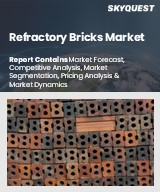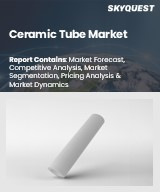
|
시장보고서
상품코드
1614897
세계의 알루미나 시장 - 규모, 점유율, 성장 분석, 제품별, 등급별, 용도별, 지역별 산업 예측(2024-2031년)Alumina Market Size, Share, Growth Analysis, By Product (Metallurgical Grade, Refractory Grade), By Grade (Chemical, Smelter), By Application, By Region - Industry Forecast 2024-2031 |
||||||
알루미나 세계 시장 규모는 2022년에 323억 달러로 평가되었고, 2023년 437억 3,000만 달러에서 2031년에는 691억 2,000만 달러로 성장해 예측 기간 중(2024-2031년) CAGR 는 5.9%로 성장할 전망입니다.
산화알루미늄(알루미나)은 특히 자동차 산업이나 컴퓨터 산업에 있어서, 방청 코팅이나 내마모성 부품 등, 다양한 엔지니어링 용도에서 점점 불가결해지고 있습니다. 뛰어난 특성은 비교적 고가인 것을 고려하면서도 선호되는 선택이 되고 있습니다. 향상시키기 위해 경량 재료를 선호하기 때문에 성능과 안전성을 높이기 위해 알루미나 부품을 채택하는 것이 두드러집니다. 또한, 신흥 시장에서의 자동차 산업의 성장은 향후 수년간에 고품질의 알루미나에 대한 수요를 더욱 에스컬레이트할 것으로 예상됩니다.
목차
소개
- 조사의 목적
- 조사 범위
- 정의
조사 방법
- 정보 조달
- 2차 데이터와 1차 데이터의 방법
- 시장 규모 예측
- 시장의 전제조건과 제한
주요 요약
- 세계 시장 전망
- 공급과 수요 동향 분석
- 부문별 기회 분석
시장 역학과 전망
- 시장 개요
- 시장 규모
- 시장 역학
- 성장 촉진요인과 기회
- 억제요인과 과제
- Porter's Five Forces 분석과 영향
- 경쟁 기업간 경쟁 관계
- 대체품의 위협
- 구매자의 협상력
- 신규 진입업자의 위협
- 공급기업의 협상력
주요 시장 인사이트
- 주요 성공 요인
- 경쟁도
- 주요 투자 기회
- 시장 생태계
- 시장의 매력 지수(2023년)
- PESTEL 분석
- 거시경제지표
- 밸류체인 분석
- 가격 분석
- 기술의 진보
- 규제 상황
- 사례 연구
알루미나 시장 규모 : 제품별 & CAGR(2024-2031년)
- 야금 등급
- 내화 등급
- 연삭 등급
- 기타
알루미나 시장 규모 : 그레이드별 & CAGR(2024-2031년)
- 화학약품
- 제련소
- 소성
- 표준 소다
- 중소다
- 저소다
- 태뷸러
- 반응적
- 융합
- 삼수화 알루미늄
알루미나 시장 규모 : 용도별 & CAGR(2024-2031년)
- 알루미늄 생산
- 알루미늄 이외의 생산
- 연마제
- 도예
- 내화물
- 여과
- 기타
알루미나 시장 규모 : 지역별 & CAGR(2024-2031년)
- 북미(제품별, 그레이드별, 용도별)
- 미국
- 캐나다
- 유럽(제품별, 그레이드별, 용도별)
- 영국
- 독일
- 스페인
- 프랑스
- 이탈리아
- 기타 유럽
- 아시아태평양(제품별, 그레이드별, 용도별)
- 중국
- 인도
- 일본
- 한국
- 기타 아시아태평양
- 라틴아메리카(제품별, 그레이드별, 용도별)
- 브라질
- 기타 라틴아메리카
- 중동 및 아프리카(제품별, 그레이드별, 용도별)
- GCC 국가
- 남아프리카
- 기타 중동 및 아프리카
경쟁 정보
- 상위 5개사 비교
- 주요 기업의 시장 포지셔닝(2023년)
- 주요 시장 기업이 채용한 전략
- 시장의 최근 동향
- 기업의 시장 점유율 분석(2023년)
- 주요 기업의 기업 프로파일
- 기업 개요
- 제품 포트폴리오 분석
- 부문별 점유율 분석
- 수익의 전년대비 비교(2021-2023년)
주요 기업 프로파일
- AnPhat Holdings
- Avantium
- BASF
- Biotec
- Braskem
- Futerro
- iome Bioplastics
- Kaneka Takasago
- LyondellBasell Industries Holdings BV
- Matrica SpA
- Mitsubishi Chemical Holding Corporation
- NatureWorks LLC
- Novamont SpA
- Plantic Technologies
- PTT MCC Biochem Co., Ltd.
- SABIC
- Solvay
- Taghleef Industries
- TEIJIN LIMITED
- Toray Industries, Inc.
결론과 권장사항
JHS 25.01.09Global Alumina Market size was valued at USD 32.3 billion in 2022 and is poised to grow from USD 43.73 billion in 2023 to USD 69.12 billion by 2031, growing at a CAGR of 5.9% during the forecast period (2024-2031).
Aluminum oxide, or alumina, is increasingly essential in diverse engineering applications, including anti-corrosion coatings and wear-resistant components, particularly within the automotive and computer industries. Its outstanding properties-such as high durability, low heat emission, and excellent thermal stability-make it a preferred choice, although its relatively high cost can be a consideration. The automotive sector is notably adopting alumina components to enhance performance and safety, as global manufacturers prioritize lightweight materials to improve fuel efficiency. This demand is particularly evident in the use of lightweight body panels and advanced load-bearing solutions for light-duty commercial vehicles. Additionally, the growth of automotive industries in emerging markets is set to further escalate the demand for high-quality alumina in the coming years.
Top-down and bottom-up approaches were used to estimate and validate the size of the Global Alumina market and to estimate the size of various other dependent submarkets. The research methodology used to estimate the market size includes the following details: The key players in the market were identified through secondary research, and their market shares in the respective regions were determined through primary and secondary research. This entire procedure includes the study of the annual and financial reports of the top market players and extensive interviews for key insights from industry leaders such as CEOs, VPs, directors, and marketing executives. All percentage shares split, and breakdowns were determined using secondary sources and verified through Primary sources. All possible parameters that affect the markets covered in this research study have been accounted for, viewed in extensive detail, verified through primary research, and analyzed to get the final quantitative and qualitative data.
Global Alumina Market Segmental Analysis
Global Alumina Market is segmented by Product, by Grade, by Application, and by Region. Based on Product, the market is segmented into Metallurgical Grade, Refractory Grade, Grinding Grade, Others. Based on Grade, the market is segmented into Chemical, Smelter, Calcined, Tabular, Reactive, Fused, Aluminium Trihydrate. Based on Application, the market is segmented into Aluminum Production, Non-Aluminum Production, Abrasives, Ceramics, Refractories, Filtration, Others. Based on region, the market is segmented into North America, Europe, Asia Pacific, Latin America and Middle East & Africa.
Driver of the Global Alumina Market
The global alumina market is poised for substantial growth by 2030, primarily fueled by the rising demand across diverse industries, particularly in defense and healthcare. Its lightweight yet strong characteristics make alumina an exceptional choice for manufacturing essential items like chest armor, including military breastplates, as well as protective gear for aircraft and vehicles. Additionally, it plays a crucial role in the fabrication of ballistic and bulletproof glass, further enhancing its appeal in security applications. As these sectors continue to expand, the demand for alumina is expected to rise, significantly contributing to the market's overall development.
Restraints in the Global Alumina Market
The global alumina market faces significant restraints due to high production costs and pressing environmental concerns. Manufacturing alumina is an energy-intensive process that involves intricate procedures, which can lead to elevated expenses that affect manufacturers' profitability and hinder market growth. Additionally, the extraction of alumina from bauxite ore raises serious environmental issues such as habitat destruction, deforestation, and water pollution. As a result, stringent environmental regulations and a growing emphasis on sustainable practices can further constrain the expansion of the alumina market, posing challenges for industry stakeholders striving for balance between profitability and ecological responsibility.
Market Trends of the Global Alumina Market
The Global Alumina market is witnessing a significant trend driven by the rising demand for lightweight materials across diverse sectors, particularly automotive, aerospace, and defense. This growing preference for alumina can be attributed to its favorable attributes, including high strength-to-weight ratio, corrosion resistance, and thermal stability, which are critical for enhancing fuel efficiency and overall performance in vehicles and aircraft. As these industries strive to meet stringent environmental regulations and improve operational efficiencies, the adoption of alumina-based components is accelerating. Furthermore, advancements in production technologies are expected to expand alumina applications, further solidifying its position in the market.
Table of Contents
Introduction
- Objectives of the Study
- Scope of the Report
- Definitions
Research Methodology
- Information Procurement
- Secondary & Primary Data Methods
- Market Size Estimation
- Market Assumptions & Limitations
Executive Summary
- Global Market Outlook
- Supply & Demand Trend Analysis
- Segmental Opportunity Analysis
Market Dynamics & Outlook
- Market Overview
- Market Size
- Market Dynamics
- Driver & Opportunities
- Restraints & Challenges
- Porters Analysis & Impact
- Competitive rivalry
- Threat of substitute
- Bargaining power of buyers
- Threat of new entrants
- Bargaining power of suppliers
Key Market Insights
- Key Success Factors
- Degree of Competition
- Top Investment Pockets
- Market Ecosystem
- Market Attractiveness Index, 2023
- PESTEL Analysis
- Macro-Economic Indicators
- Value Chain Analysis
- Pricing Analysis
- Technological Advancement
- Regulatory Landscape
- Case Studies
Global Alumina Market Size by Product & CAGR (2024-2031)
- Metallurgical Grade
- Refractory Grade
- Grinding Grade
- Others
Global Alumina Market Size by Grade & CAGR (2024-2031)
- Chemical
- Smelter
- Calcined
- Ordinary soda
- Medium soda
- Low soda
- Tabular
- Reactive
- Fused
- Aluminium Trihydrate
Global Alumina Market Size by Application & CAGR (2024-2031)
- Aluminum Production
- Non-Aluminum Production
- Abrasives
- Ceramics
- Refractories
- Filtration
- Others
Global Alumina Market Size by Region & CAGR (2024-2031)
- North America (by Product, by Grade, by Application)
- US
- Canada
- Europe (by Product, by Grade, by Application)
- UK
- Germany
- Spain
- France
- Italy
- Rest of Europe
- Asia-Pacific (by Product, by Grade, by Application)
- China
- India
- Japan
- South Korea
- Rest of Asia Pacific
- Latin America (by Product, by Grade, by Application)
- Brazil
- Rest of Latin America
- Middle East & Africa (by Product, by Grade, by Application)
- GCC Countries
- South Africa
- Rest of Middle East & Africa
Competitive Intelligence
- Top 5 Player Comparison
- Market Positioning of Key Players, 2023
- Strategies Adopted by Key Market Players
- Recent Developments in the Market
- Company Market Share Analysis, 2023
- Company Profiles of All Key Players
- Company Details
- Product Portfolio Analysis
- Company's Segmental Share Analysis
- Revenue Y-O-Y Comparison (2021-2023)
Key Company Profiles
- AnPhat Holdings
- Company Overview
- Business Segment Overview
- Financial Updates
- Key Developments
- Avantium
- Company Overview
- Business Segment Overview
- Financial Updates
- Key Developments
- BASF
- Company Overview
- Business Segment Overview
- Financial Updates
- Key Developments
- Biotec
- Company Overview
- Business Segment Overview
- Financial Updates
- Key Developments
- Braskem
- Company Overview
- Business Segment Overview
- Financial Updates
- Key Developments
- Futerro
- Company Overview
- Business Segment Overview
- Financial Updates
- Key Developments
- iome Bioplastics
- Company Overview
- Business Segment Overview
- Financial Updates
- Key Developments
- Kaneka Takasago
- Company Overview
- Business Segment Overview
- Financial Updates
- Key Developments
- LyondellBasell Industries Holdings B.V.
- Company Overview
- Business Segment Overview
- Financial Updates
- Key Developments
- Matrica S.p.A.
- Company Overview
- Business Segment Overview
- Financial Updates
- Key Developments
- Mitsubishi Chemical Holding Corporation
- Company Overview
- Business Segment Overview
- Financial Updates
- Key Developments
- NatureWorks LLC
- Company Overview
- Business Segment Overview
- Financial Updates
- Key Developments
- Novamont S.p.A
- Company Overview
- Business Segment Overview
- Financial Updates
- Key Developments
- Plantic Technologies
- Company Overview
- Business Segment Overview
- Financial Updates
- Key Developments
- PTT MCC Biochem Co., Ltd.
- Company Overview
- Business Segment Overview
- Financial Updates
- Key Developments
- SABIC
- Company Overview
- Business Segment Overview
- Financial Updates
- Key Developments
- Solvay
- Company Overview
- Business Segment Overview
- Financial Updates
- Key Developments
- Taghleef Industries
- Company Overview
- Business Segment Overview
- Financial Updates
- Key Developments
- TEIJIN LIMITED
- Company Overview
- Business Segment Overview
- Financial Updates
- Key Developments
- Toray Industries, Inc.
- Company Overview
- Business Segment Overview
- Financial Updates
- Key Developments



















